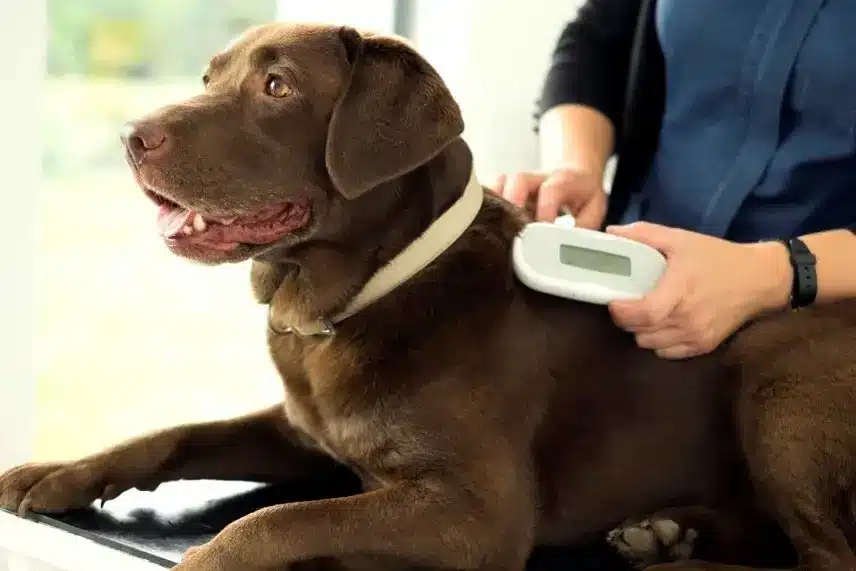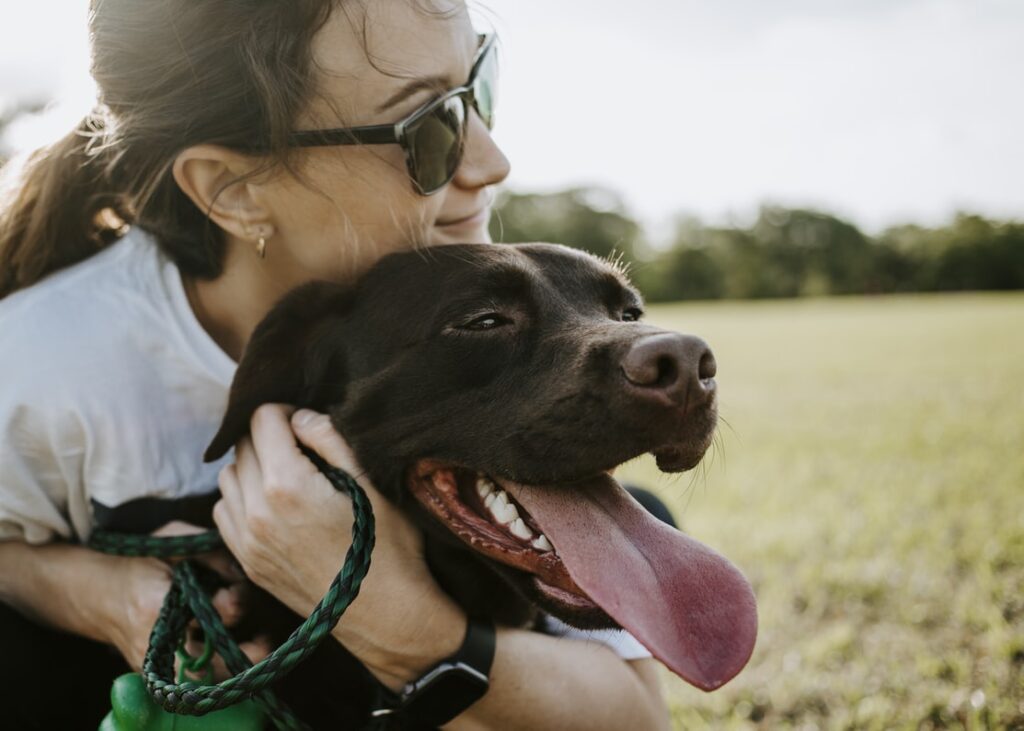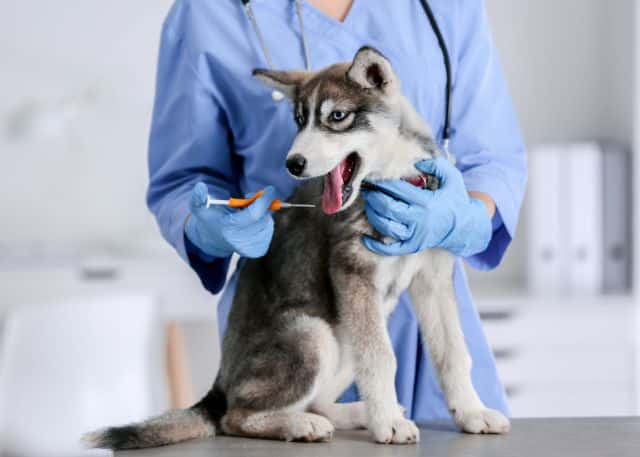What Is Microchipping for Dogs and Cats?
Pet microchipping is a quick and safe procedure that implants a tiny RFID microchip under your pet’s skin. About the size of a grain of rice, this permanent electronic device provides a reliable form of identification for your furry friend. By linking a unique identification number to a national microchip database, pet microchips significantly increase the chances of reuniting lost pets with their owners. The microchip is implanted just beneath the skin between your pet’s shoulder blades a location that allows easy scanning by microchip readers at veterinary clinics and animal shelters. This simple implantation process causes minimal discomfort, similar to a routine vaccination, and can often be performed during other veterinary procedures such as neutering. Once implanted, the pet microchip acts as a one-time transponder that provides permanent identification for the lifetime of your companion animal.
Microchipping is recommended for all dogs and cats because collars and tags can easily be lost or removed, while microchips offer a secure and permanent form of pet ID. The RFID chip is implanted quickly using a preloaded syringe and takes only a few seconds to insert. The procedure does not require anesthesia and is generally as painless as a routine vaccination.
Requirements for Pet Microchipping?
In the UK, pet owners may face fines of up to GBP £500 if their dog is not microchipped before it reaches 8 weeks of age, highlighting the legal importance of microchip registration for pet safety. Similarly, Hong Kong requires all dogs to be microchipped before entry, and resident dogs over 5 months old must also be chipped. Pet owners should be aware of these key regulations when preparing to microchip their cat or dog.
Age
Most veterinarians recommend animal microchipping when your pet is between 4 and 6 months old. By this age, pets are large enough for safe microchip insertion, and their rapid growth has slowed. However, some regions have specific legal requirements; for example, in the UK, dogs must be microchipped by 8 weeks old. It’s important to check local regulations and consult with your veterinarian to determine the best timing for your pet’s microchipping.
Registration
Be sure to have the microchip registration completed, including your current contact details in the the national microchip database associated with the chip’s ID number. This will help reunite you with your pet if they are lost. Keep your information up to date in the database, especially if you move or change phone numbers. Proper registration ensures that animal shelters concerned departments can contact you promptly if your pet is found.
Location
The pet microchip must be implanted beneath the skin between your pet’s shoulder blades, at the back of the neck. This standard location ensures the chip remains secure and can be easily scanned. Standard microchip insertion places the RFID chip under the skin between the shoulder blades, facilitating easy scanning with a microchip reader at shelters and veterinary clinics. The procedure is quick and relatively painless, much like a routine vaccination. Your veterinarian will confirm the microchip is properly placed and provide aftercare instructions.
Scanning
Schedule a visit to your vet about two weeks after implantation to scan and confirm that the pet ID chip is functioning and readable. This follow-up ensures that the microchip is still in place and can be detected by a scanner. Regularly checking the pet ID chip during annual vet visits can help prevent identification issues if your pet ever gets lost.
There are different chips used in different countries.
For example, in Hong Kong, if the microchip does not contain the HK type of AVID 9-digit number required by Hong Kong authorities, then your dog will be re-chipped at the airport. This procedure is not required for cats, any type of microchip is ok.
Why Is Pet Microchipping Used?
Microchipping is a quick, safe and simple device/procedure that has successfully reunited thousands of pets with their owners. If your pet was to get lost or stolen, having your pet microchipped dramatically increases your chances of being able to find it again. If pets are found and taken to a local vet or animal shelter, they can scan your pet’s microchip and contact you.
It’s used internationally as the most reliable way to identify pets, linking documents with the pet’s microchip number. Many countries, including those in the EU, UK, and Australia, require pets to have an ISO-compliant microchip (ISO 11784/11785) for travel and official ID. These microchips have a unique 15-digit code readable by universal scanners worldwide, ensuring easy identification across borders. Also, there are several key reasons why microchipping is important for your dogs and cats:
1. Permanent identification
The pet microchip provides a permanent way to identify your pet even if its collar and tags are lost. The microchip has a unique ID number registered to the owner in a database. Unlike collars that can break or tags that can fall off, a microchip stays with your pet for life, ensuring a reliable form of identification. This means that no matter where your pet goes or what happens to its external identifiers, its microchip will always serve as a definitive link to you.
2. Reuniting lost pets
Animal shelters and veterinary offices have scanners to detect microchips. So, if your lost pet arrives at a facility, they can scan the chip and contact you. This quick identification process significantly speeds up the reunion process, reducing the time your pet spends away from home and minimizing their stress. The quicker your pet is identified, the faster it can be returned to the safety and comfort of its home, making microchipping an invaluable tool for pet recovery.
3. Proof of ownership
Microchips serve as reliable proof of pet ownership, confirming that the pet legally belongs to you. They are especially helpful in resolving disputes about ownership if a pet ends up in a shelter. In cases of theft or legal disagreements, a registered microchip provides clear, verifiable evidence, which can be crucial in ensuring your pet is returned to you. This legal clarity is essential when ownership is contested or when pets are lost or stolen.
4. Identification of injuries/illnesses
Microchips can be implanted under your pet to store medical information, such as allergies, medical history, or even vaccination. Animal shelters or vet offices can identify health conditions if a chipped pet is found injured or ill. This immediate access to vital health data can be lifesaving in emergencies, allowing for prompt and appropriate medical care. Knowing a pet’s medical background can significantly improve the effectiveness of treatment provided during critical situations.
5. Deterrent to Theft
Microchips provide clear proof of ownership, making them a powerful deterrent against pet theft. When a stolen pet is found, the registered microchip enables law enforcement, animal shelters, and veterinary clinics to quickly identify the animal and return it to its rightful owner. This reliable system not only discourages criminals from stealing pets but also plays a vital role in pet recovery and ensuring the safety and security of your companion.
Does a microchip implant procedure cause my pet any pain?
Many pet owners wonder if implanting a microchip is painful or stressful for their furry companions. But for your peace of mind, microchipping does not hurt your pets much. The process of pet microchipping is quick and painless. There is only a momentary pinch during the microchip implantation, which is pretty much similar to a routine vaccination shot. The veterinarian or trained implanter uses a specialized preloaded syringe to insert the microchip under the skin, which takes just a few seconds. Most pets show no signs of pain or discomfort and usually return to normal behaviour immediately after microchipping.
How Does Microchipping Work in Dogs and Cats?
Every pet microchip contains a unique identification number that can be read using a microchip scanner or reader, linking the pet to its owner’s contact information in a secure registry.
It’s also (often, depending on country) held on a database along with your contact details. Whenever your pet is scanned, your details will appear. Therefore, it is vital that your contact details are kept up to date on the relevant national database in case your pet is lost or stolen. The database your pet is registered with should be alerted if your number, name or address are to change. This is the owner’s responsibility.
Additionally, if a pet’s owner changes the database will need to be updated. Microchipping is not a substitute for your pet wearing a collar and tags. These are prone to falling off but a microchip is permanent.
Does A Microchipping Track My Pet?
While microchips are very useful for identifying lost pets when they arrive at a shelter or vet clinic, the chips cannot pinpoint exactly where your pet is if it is lost. The microchips implanted in cats, dogs, and other animals are simple ID devices rather than GPS trackers. Here’s how microchips work and why they don’t track your pet’s movements:
- The microchip itself contains no internal power source or GPS technology. It is a small, inert chip encapsulated in a glass capsule.
- The chip contains a unique identification number that matches the pet’s registration in an external database.
- Microchips are only activated when scanned by a nearby microchip reader device. They do not emit constant signals.
- The microchip provides permanent pet identification but does not offer real-time location tracking capabilities.
Who can microchip your pet?
Pet microchipping is a simple procedure that does not legally require a licensed veterinarian to perform. Veterinarians, animal shelter staff, and vet clinics can all perform microchipping for cats and dogs. Some local animal charities, organizations, and authorities may also offer this service for free. As long as the person is properly trained to implant the pet microchips and complete the microchip registration, they can legally provide microchipping services.
How can I find out the details of my pet’s microchip?
To find the details of your pet’s microchip, take your pet along to any vet; they can scan your pet’s chip with a microchip scanner and see the details. Changing the details on your pet’s microchip is not possible, although the record can be changed at the database – you will need to contact directly the database your details are stored on. Your vet will be able to help you do this.
Can a microchip become damaged?
Because of the minute size, your cat’s or dog’s microchip is challenging to get damaged and removed. They are designed to be inserted once and not taken out. However, in very rare cases severe damage to your pet’s back and neck to could also cause damage to your pet’s microchip. On rare occasions microchips may be rejected by your pet’s body. In rare cases, we have seen the dogs’ and cats’ microchips become inactive, but this is incredibly rare.
Can all pets be microchipped?
While microchipping is suitable for most common household pets, there are some limitations on which animals can be safely and effectively microchipped. For cats and dogs, microchipping is recommended and widely performed, even on small breeds. Other common pets like rabbits, ferrets, birds, reptiles, and horses can also be successfully microchipped in most cases.
However, small companion animals like hamsters may be too tiny for chip implantation. Aquarium fish and invertebrates, like insects, are generally not considered for microchips either.
Conclusion
Microchipping plays a pivotal role in ensuring the safety and welfare of pets, especially during travel or relocation. As a pet relocation company, we strongly recommend having your pet microchipped before any upcoming move. A registered microchip serves as a permanent form of electronic identification, providing essential protection if your pet becomes lost or separated during transport. It significantly increases the chances of a quick reunion. Just as important, make sure the pet microchip is properly registered and that your contact details remain up to date with the microchip provider. Microchipping is a simple step that greatly enhances both pet safety and animal welfare.
Click Here For Shipping Enquiry
Frequently Asked Questions
Why is it important to microchip your pet?
Microchipping your pet is extremely important because it is the best way to ensure your lost pet can be identified and returned to you. The microchip is scannable, so shelter staff or vets can quickly scan for the chip and look up your contact info.
Can I track my dog with a microchip?
No, you cannot track your dog with a microchip. Microchips do not have GPS capabilities and cannot track the real-time location of a pet. They only provide a means of identification when scanned.
Are there any side effects of microchipping dogs?
Microchipping is generally safe and causes minimal side effects. Most dogs feel little to no discomfort, similar to a routine vaccination. Some may experience mild swelling or redness at the injection site, which usually goes away quickly. Serious complications are very rare. Overall, the benefits of microchipping far outweigh the minimal risks.
Can you read a pet microchip with your phone?
Unfortunately, you cannot currently scan a pet microchip with a phone. You need a microchip scanner to read a pet microchip for this.
Are dogs in pain after microchipping?
The microchip implantation is no more painful than a routine vaccination shot for dogs. Most dogs show no signs of pain or discomfort within 24 hours after getting microchipped.
Can microchips be used for pet identification during travel or relocation?
Yes, microchips are widely accepted as a reliable form of pet identification during travel and relocation. Many airlines and countries require pets to be microchipped before entry to confirm ownership and assist in identification if your pet gets lost during transport.
What should I do if I lose my pet’s microchip registration details?
If you lose your pet’s microchip registration details, contact the microchip registry or database where your pet is registered. Most registries allow you to recover or update your contact information online or via customer support. Keeping your details current ensures you can be contacted if your pet is found.





